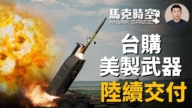【新唐人2012年10月5日訊】軍事評論家平可夫在最新一期出版的《漢和防務評論》中說,中國建造的空軍基地「糟糕」,打起仗來肯定「戰敗」。平可夫指出,中國空軍的戰鬥機,即使今日在多數機場的,仍然都是土堆型機堡堆放,或者一字排開,阿拉伯國家這種類型的飛機場,曾經在1967年第三次中東戰爭的時候,遭到以色列空軍攻擊,瞬間全軍覆沒。
平可夫在文章開頭就指出,一支真正打過現代化戰爭的空軍,從基地建設就可以看出是否能夠首戰必勝。J7、J8戰鬥機,即使今日在中國空軍多數機場的,仍然都是土堆型機堡堆放,或者一字排開,他因此感嘆,這是支不思進取的空軍。
文章說,當今所有空軍強國的空軍基地建設經驗,都是吸取第三次中東戰爭的結果,就是著名的以色列空軍「7點45分攻擊」。
當時,蘇聯模式建設起來的埃及空軍,將戰鬥機一字排開放在機場,或者停放於土堆式的機堡中,以色列空軍只用了20分鐘就全殲了將近400架各式埃及作戰飛機。原埃及飛行員說:「不是沒有進行空戰,而是根本沒有機會進行過戰鬥。」
時政評論家 伍凡:「中國空軍這幾十年來沒有打過仗。不如埃及和以色列打過。中東的世紀戰爭,他們的空軍都有交往,伊朗,以色列,伊拉克,阿富汗,他們的空軍有作戰經驗,唯獨中國這個大國,共產黨的空軍,他沒有作戰經驗。」
文章說,第三次中東戰爭之後,蘇式、美式空軍的國家,相繼改變了空軍基地的建設式樣。吸取這一次戰爭的經驗,當然是如何重點保護被空襲的戰鬥機,並且強化快速起飛能力。
再看中國的空軍基地,這一類最好待遇的機場諸如空3師J10戰鬥機團,空6師銀川基地、空1師赤峰J10團基地等,都修建了簡易型一線維修保障機庫,同時擁有地下洞庫,一般情況下,洞庫存在兩個出口,張家口的空7師地下洞庫有四個出口。至少50%的中國空軍基地修建了大型的地下洞庫,這是中國吸取第三次中東戰爭教訓的結果。但多數的中國空軍機場只有一條跑道,邏輯顯然是先藏好飛機為主。
伍凡:「他們現在雖然在沿海第一線,第二線,對保護飛機,建立飛機庫,保護機場,有一點概念了,但是畢竟沒有產生血的教訓,所有這些引擎製造,保護自己機場這些概念,還是沒有深入到這些軍隊裡頭。只有狠狠吃了虧,流血犧牲之後,你才知道怎樣保護機場,保護自己反擊的能力。嘴上是這樣講,但是沒有實際經驗,只有通過戰爭才能考驗。」
真正經歷過戰爭洗禮的國家,如埃及空軍、巴基斯坦空軍反而不修地下洞庫。他們的理論家認為,在鐳射制導炸彈、制導武器高度發達的今日空軍作戰環境中,僅僅有2個或者4個出口的洞庫型機庫,一旦庫門被命中,所有飛機不得不退出戰鬥,即使不被摧毀,那還不等於失去了制空權?因此埃及空軍的邏輯是,不能等,要緊急儘快起飛。
2000年以後,中國的若干空軍基地才開始積極修建更多的強化型、隱蔽式堡壘機庫。福建前線的機場基本完成了類似機庫的建設。空2師的遂溪基地是最先建設美式機庫的機場,同時擁有簡易型一線維修堡壘型機庫。最近空29師也建設了類似的堡壘型機庫。
採訪編輯/秦雪 後製/肖顏
Chinese Air Force Rated “Lousy"
The latest issue of Kanwa Defense Review published
an article by military commentator Andrei Chang.
It asserted that the Chinese Air Force Base
is “lousy" and would “be defeated" in a war.
The article said, Chinese Air Force fighters are usually
parked in mound-type bunkers or lined up in the airfields.
During the 1967 Middle East War, the Arab air forces,
parked similarly, were easily destroyed in the Israeli attack.
Andrei Chang remarked that in the sense of modern war,
air force base construction is determinant of its first victory.
China’s J7 and J8 fighters are now mostly being parked
in mound-type bunkers or lined up in the airfields.
Chang thus commented
that this is an inertia type air force.
The article said that countries with powerful air forces
have all taken lessons from the 1967 Middle East war.
On June 5, 1967, at 7:45 am, the Israeli Air Force attacked
airfields across Egypt.
At that time, the Egyptian Air Force fighters were all lined up
on the airfield or parked in the mound-type bunkers.
Within 20 minutes, 400 Egyptian fighters were wiped out.
The article cited a former Egyptian pilot as saying,
“It wasn’t defeated in air combat, it failed to even get a chance to fight back.”
Critic Wu Fan: “Over past decades, Chinese Air Forces
haven’t been in wars, but both Egypt and Israel have.
Air Forces of Iran, Israel, Iraq and Afghanistan
have all had combat experiences, too."
Chang’s article said, after the 1967 Middle East War,
Air Forces of both the former Soviet Union and the US changed the construction of their air force bases.
Constructions were designed to protect fighters in air raids,
and to accelerate fighter’s take-off.
Andrei Chang pointed out that China’s best air force bases
have built simple aircraft hangars and underground caverns.
The 7th Air Division stationed in Zhangjiakou built four exits
for each underground hangar compared to the usual two.
At least 50% of the Chinese Air Force bases learnt from the
1967 war by building underground caverns, the article said.
However, in most Chinese Air Force airports
there is only one runway.
Andrei Chang commented that the logic behind it
is aiming to hide the fighters.
Wu Fan: “They have some idea on protecting fighters,
but they still haven’t had any experience in war.
The air force still lack knowledge about engine production
and airfields protection, among others concepts.
How to protect the airfield and counterattack capability?
This can only be learnt by experiencing a real war.
It’s useless to give only lip service
without practical experiences.”
After having experienced wars, the air forces of Egypt
and Pakistan have not constructed underground caverns.
As underground caverns can be easily targeted
by today’s laser-guided bombs and weapons.
That would amount to losing air supremacy.
Therefore, the Egyptian Air Force prioritized to accelerate
fighters’ take-off, according to Chang’s article.
Andrei Chang revealed that it was not until after 2000,
when some of China’s air force bases began to build more fortified and sheltered aircraft bunkers.
Fujian’s frontline airfield
has almost completed such constructions.
The 2nd Air Division based at Suixi built it’s first US-style
aircraft bunkers and simple aircraft fortress-type hangars.
Recently, the 29th Air Division has constructed
similar fortress-type hangars.





























